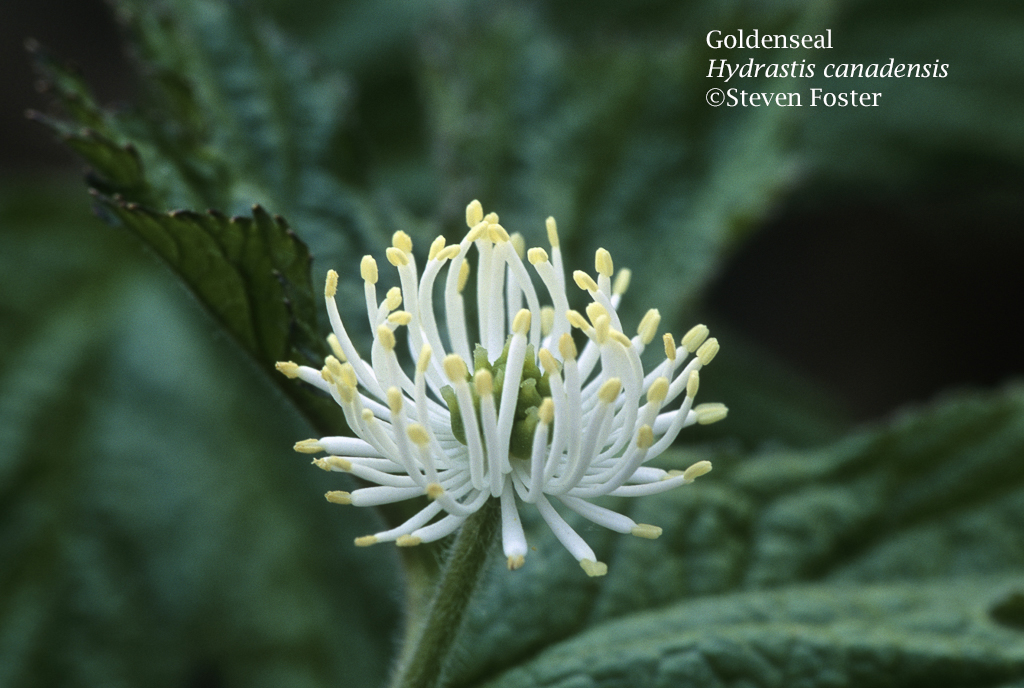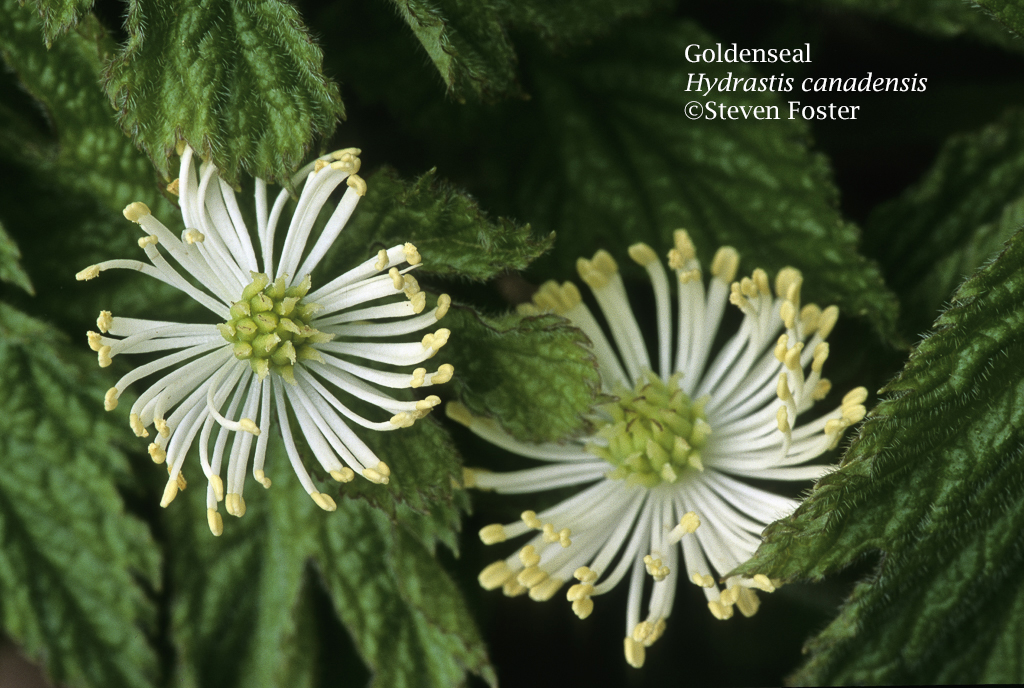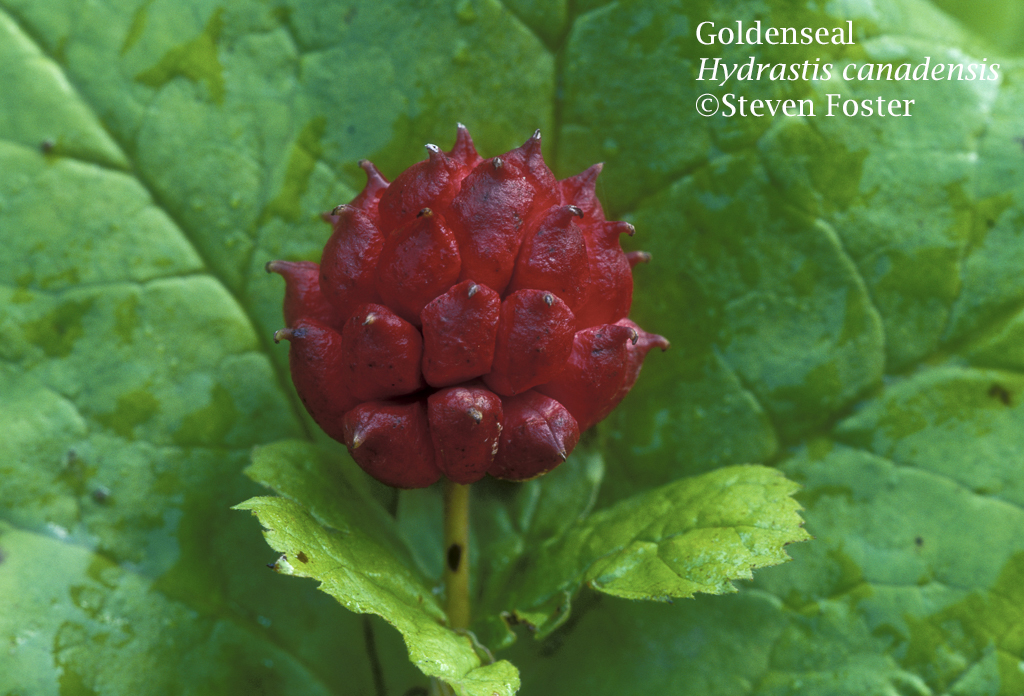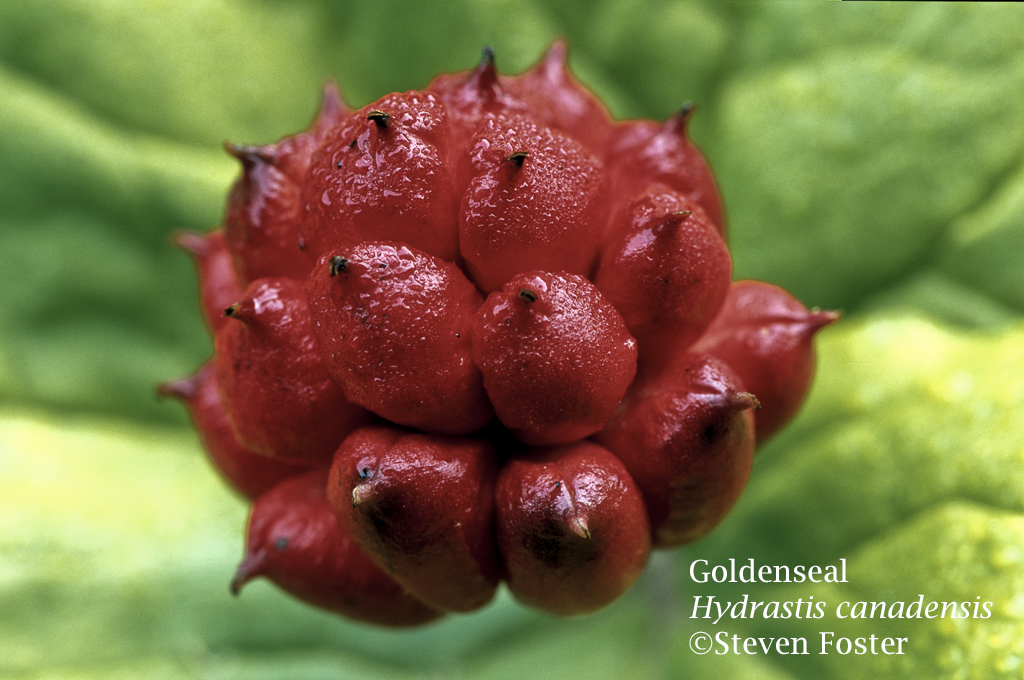Goldenseal (Hydrastis canadensis)
Goldenseal, an herbaceous perennial herb, grows slowly in rich woods in the eastern deciduous forest from Vermont to Georgia, west to Alabama and Arkansas, north to eastern Iowa and Minnesota, with the highest concentration in the Ohio River Valley.Goldenseal History
Steven Foster writes that one of the first western sources of information on goldenseal is Benjamin Smith Barton’s Essays Towards a Materia Medica of the United States (published in three parts from 1798 to 1804). Barton mentions that the Cherokee used the plant as a remedy for cancer, one of the first observations of treatment for cancer among Native Americans.[1] Goldenseal (golden seal) is the common name under which the plant is best known. This name was adopted in the 1880 revision of the United States Pharmacopoeia. Previously, the plant was known in commerce as yellow root, an ambiguous name referring to several other plants. It has also been known as orange root, yellow puccoon, ground raspberry, eye-balm, and eye-root. The name goldenseal was introduced by Samuel Thomson, (1769–1843) who popularized its use in the 1820s. The small cup-like scars of previous annual stems, found on the upper-side of the yellow rhizome, have the appearance of wax seals, once used to seal envelopes, hence the common name. [2]Goldenseal Uses
The root, beaming with bright yellow-orange berberine, is traditionally used in tea or tincture to treat inflamed mucous membranes of mouth, throat, digestive system, and uterus.[3] Used since time immemorial by indigenous groups, the Cherokee used the roots as a wash for local inflammations, and in decoction for general debility, dyspepsia, and to improve appetite. The Iroquois used a decoction of the root for whooping cough, diarrhea, liver trouble, fever, sour stomach, flatulence, pneumonia, and, with whiskey, for heart trouble. [4] This reflects the diverse use for goldenseal over the centuries. One curious modern folk use which exploded in the late 1990s leading to wholesale supply shortages and concern for goldenseal’s conservation status literally has novel beginnings. As drug testing became common in the workplace, the consumption of goldenseal in an attempt to mask urine tests for illicit drugs became common, with goldenseal products even available at the checkout counter at truck stops. The notion that goldenseal affects chemical analytical tests grows out of a fictional plot of the 1900 novel Stringtown on the Pike, by pharmacist and goldenseal expert, John Uri Lloyd (1849-1936). There is no scientific evidence to support this use, in fact, it may instead promote false-positive readings. [5, 6].





Goldenseal Sustainability
The threats to goldenseal include the impact of habitat loss and domestic and international trade. The Convention on International Trade in Endangered Species of Wild Fauna and Flora (CITES) has included goldenseal in Appendix II since 1999, and the International Union for the Conservation of Nature (IUCN) Red List of Threatened Species lists goldenseal as vulnerable. Between 1999 and 2010, as much as 105,099 dry pounds of goldenseal was harvested annually. With only 26-31% of that volume coming from cultivated sources during that time, sustainable stewardship and forest farming practices are critical for conserving goldenseal populations.[7]
For additional detailed information on goldenseal, see the United Plant Savers (UpS) video “Hope for Hydrastis” and the UpS Goldenseal At-Risk profile.
Dig Deeper
- Goldenseal UpS At Risk page for more information on the conservation status of goldenseal.
- “Investing in Forests and Communities: A Pathway to a Sustainable Supply of Forest Herbs in the Eastern UnitedStates,” by Holly Chittum, Eric Burkhart, John Munsell and Steven Kruger. HerbalGram (2019; 124:60-76).
- For more videos on Forest Farming, see the Appalachian Beginning Forest Farming Coalition YouTube Channel.
- For information on how to grow and market goldenseal, check out:
- Growing and Marketing Ginseng, Goldenseal and other Woodland Medicinals by Jeanine Davis and W. Scott Persons.
- The Forest Farmers Handbook by Rural Action and United Plant Savers
- Virginia Tech’s Root Report for more information on goldenseal trade.
- IUCN Red List status of goldenseal as vulnerable.
- The Future of Ginseng & Forest Botanicals Symposium Proceedings, by UpS. Download a free PDF on their website here.
- Albrecht, Matthew & McCarthy, Brian. (2009). Comparative Analysis of Goldenseal (Hydrastis canadensis L.) Population Re-growth Following Human Harvest: Implications for Conservation. The American Midland Naturalist. 229-236. 10.1674/0003-0031(2006)156[229:CAOGHC]2.0.CO;2.
- Goldenseal’s Future by Steven Foster??
References Cited
- Foster, S. Goldenseal’s Future.
- Lloyd JU, Lloyd CG. 1884-85. Drugs and Medicines of North America: Ranunculaceae. Cincinnati, OH: J.U. Lloyd & C.G. Lloyd. 1884-85;(1):76-184
- Foster S. Goldenseal Hydrastis canadensis. 2nd. ed. Botanical Series. Austin, TX: American Botanical Council. 1996;309.
- Moerman D. Native American Ethnobotany. Portland, OR: Timber Press. 1998.
- Lloyd JU. Stringtown on the Pike. New York: Dodd Mead. 1900.
- Foster S. Goldenseal—Masking of Drug Tests from Fiction to Fallacy: An Historical Anomaly. HerbalGram 1989;21:7,35.
- Oliver LE, Leaman DJ. Protecting Goldenseal: How Status Assessments Inform Conservation. HerbalGram. 2018;119;40-55.
